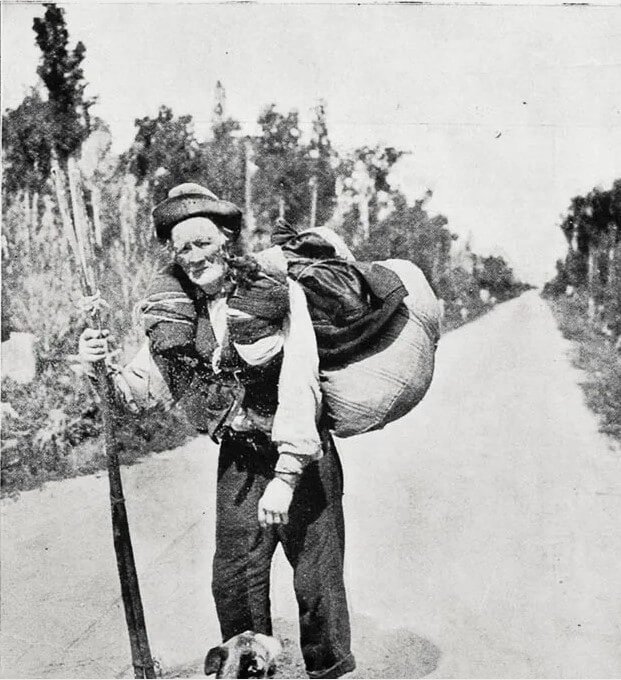
A swagman
The meat was raw, fresh from Turnwald’s butchery in Ōhaupō, but William Brook immediately started eating it.
A swagman, he lived a nomadic life travelling miles by foot in search of work, carrying a bundle of belongings, a tin billy and a small metal cup on his back. William had come to Ōhaupō about five weeks previously in January 1904 with another man. William obtained work but his companion left the next day.
A swagger’s life was difficult. Farmers, who were once welcoming and offered work now did not. Some would supply tucker but refuse shakedowns (accommodation), others refused both. Shakedowns were sometimes warm and comfortable; others were frightful – damp, freezing, derelict, crawling with vermin. Illness from exposure to cold and rain was common. Hygiene was sporadic and swags tiring to carry. Misconceptions about swaggers led to children calling out insults or throwing stones at them. The swagger was continually anxious wondering where the next meal or bed would come from.
For William Brook his next meal was his last. Moments after eating the raw beef he started choking and within minutes was dead. He was a quiet man and a steady worker. He was thought to be a Scotsman, aged about 50. Eight shillings were found in his possession, but not much else to identify him or explain how he ended up wandering the roads.
A swagger’s life was difficult.
In October of the same year a swagger known as Mad Mick came into the Ōhaupō Hotel asking for beer. He was barely able to walk or breathe and John Teddy, hotelkeeper, refused to serve him. After half an hour he gave Mick some schnapps, then soup and organised a shakedown to be prepared for him in the horse stable. The next morning Mick was very ill, and John Teddy telegraphed the Te Awamutu police. When Constable McPhee arrived, he found Mick in a filthy condition and asked for disinfectant before touching him. Mick was in a state of total collapse. Constable McPhee took him in a buggy to Hamilton hospital where he died. At the inquest Dr Douglas said Mick had signs of pneumonia, heart disease and alcoholic cirrhosis. Death was due to exposure and neglect, the neglect being of long standing. The jury acknowledged that John Teddy and others appeared to have done everything they could for him.
Mad Mick’s real name was Michael Barry and he had been around the Waipā area for about four years doing odd jobs and sleeping outdoors. He called at the Ōhaupō hotel about every two months. He never spoke of his family, but Constable McPhee ascertained that he was 63, from Ireland and had been in New Zealand 40 years. He had been a soldier in earlier years. He had 3s 6d in his pocket, and his other belongings were worthless.
Mad Mick was buried at Hamilton East cemetery; William Brook’s death was registered at Te Awamutu but the uncertainty that dominated his life followed him to his grave, the whereabouts of which are unknown.








